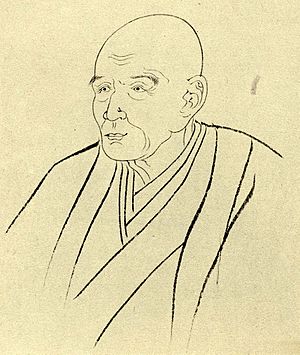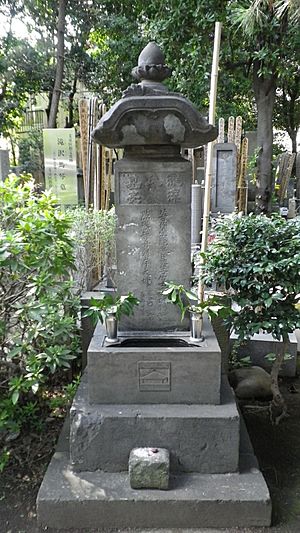Takizawa Bakin facts for kids
Quick facts for kids
Takizawa Bakin
|
|
|---|---|

Bakin's portrait by Kunisada (国貞)
|
|
| Native name |
滝沢 馬琴
|
| Born | Takizawa Okikuni (滝沢興邦) 4 July 1767 Fukagawa, Edo, Japan |
| Died | 1 December 1848 (aged 81) Shinano Hill, Japan |
| Resting place | Jinkōji Temple, Tokyo, Japan |
| Pen name | Kyokutei Bakin (曲亭馬琴) |
| Genre | Gesaku (Yomihon) |
| Notable works |
|
| Spouse |
Aida Ohyaku
(m. 1793–1841) |
| Children |
|
Takizawa Bakin (滝沢 馬琴), also known as Kyokutei Bakin (曲亭 馬琴), was a very famous Japanese novelist. He lived from July 4, 1767, to December 1, 1848, during Japan's Edo period. His birth name was Takizawa Okikuni. He used the pen name Kyokutei Bakin for most of his writing.
Many people consider Bakin to be one of the most important writers of early 19th-century Japanese literature. He was born into a Samurai family, but they were not very high-ranking. After many sad events in his family, he decided to leave his samurai life. He married a merchant's widow and became a regular townsperson in Edo (which is now Tokyo).
Bakin was a very busy writer. He wrote many gesaku stories, which were mostly historical romances that taught lessons. He always hoped to bring his family back to the samurai social class. Some of his most famous books include Nansō satomi hakkenden (The Chronicles of the Eight Dog Heroes of the Satomi Clan of Nansō), which has 106 books, and Chinsetsu yumiharizuki (Strange Tales of the Crescent Moon). Bakin published over 200 works in his lifetime, including book reviews, diaries, and historical novels.
Contents
Bakin's Life and Writing Journey
Early Life and Family
Bakin was born in Edo (today's Tokyo) on July 4, 1767. He was the fifth son of his parents, Bunkurō Omon and Takizawa Okiyoshi. Sadly, two of his older brothers died when they were babies.
Bakin's father, Okiyoshi, was a Samurai who worked for a lord named Matsudaira Nobutsuna. His father was very dedicated to studying old Chinese books, especially about military topics. He was a hardworking samurai, but he got sick and died in 1775. After his father's death, Bakin's family faced financial difficulties.
His mother, Omon, was a good mother and wife. The family lived in the Matsudaira mansion for a while. However, as their family's connection to the Matsudaira clan ended, they had to move to a much smaller home. Bakin's older brother, Keichū, was adopted by another family to help with money. At just nine years old, Bakin became the head of his family. His mother later became ill and passed away in 1785.
When he was 14, in 1780, Bakin decided to become a rōnin. A rōnin was a samurai who no longer served a lord. He even wrote a short poem (called a haiku) about his decision:
- こがらしに
- 思い立ちけり
- 神の旅
- Chilled by winter winds
- I have decided
- To journey with the gods.
Bakin tried to find other samurai positions, but he was never satisfied. He left each job quickly. His brother Keichū died in 1786, which made Bakin think deeply about his life. He became ill in 1788 and decided to stop being a samurai for good.
He tried studying medicine, but he didn't like it. Then he tried different jobs like being a comic poet, a fortuneteller, a comedian, and a scholar of Confucianism (a system of ideas from ancient China). A big change happened for Bakin in 1790. He met a very successful author named Santō Kyōden. Bakin asked Kyōden for help publishing his first book, Tsukaihatashite nibu kyogen.
In 1798, Bakin's last remaining older brother died. This meant Bakin was the only male left in the Takizawa family. He promised himself he would work hard to bring his family's name and status back.
Becoming a Famous Author
Bakin's first book, Tsukaihatashite nibu kyogen, was published in 1791. He used the pen name "Daiei Sanjin, Disciple of Kyoden." This book taught lessons, and Bakin continued to write in this style for most of his career. This was a good choice because new laws had come out in 1790 that were strict about what authors could write. Bakin's focus on teaching lessons helped him avoid trouble that other writers faced.
In 1793, Bakin married Aida Ohyaku. She was a widow who owned a shoe shop. This marriage helped Bakin financially. They had four children together: three daughters and one son. After his mother-in-law died in 1795, Bakin had more time to write.
In 1796, he published his first yomihon (a type of Japanese novel) called Takao senjimon. His books became popular across Japan, even reaching Kyoto and Osaka. By 1797, he had eleven more books published, and he continued to publish about ten books a year until 1802.
In 1800, Bakin started taking long walking trips. These trips were very important for his life and his writing. He visited many historical places that he later used in his stories. During these travels, he decided even more strongly to use his writing to restore his family's status.
His second long trip in 1802 took him along the Tōkaidō Post Road. He saw many different kinds of people and experienced a time of widespread flooding. These experiences made his novels feel very real and honest, which made them popular with people from all walks of life in Japan.
From 1803 to 1813, Bakin published thirty historical novels. This was the start of his full career as a professional writer. Many of his stories were even turned into plays for the theater. By 1810, Bakin was earning a good living from his writing. He was making more money than his family had received as samurai, and he was considered the top author of historical novels.
His success was also due to working with famous artists. From 1804 to 1815, Bakin worked with the talented illustrator Hokusai on 13 books. One famous collaboration was Chinsetsu yumiharizuki, published between 1807 and 1811. Bakin and Hokusai eventually stopped working together, possibly because they had different personalities or ideas about how the illustrations should look.
By 1818, Bakin had bought a second house with the money from his books and his wife's business. This meant the Takizawa family's status was officially restored. In 1820, Bakin's son, Sōhaku, became a doctor for a lord. This officially made his social class samurai again. Bakin felt his family's future was secure.
During this time, Bakin started writing his most famous work, Nansō satomi hakkenden. This huge story has 106 volumes, making it one of the longest novels in the world! It took him 28 years to complete, from 1814 to 1842. Like most of his books, Hakkenden focused on samurai themes like loyalty and family honor, as well as ideas from Confucianism and Buddhist philosophy. While writing this massive book, Bakin became less involved in public life.

Later Years and Passing
While writing, Bakin also made sure his children married well. His daughter Osaki married Yoshida Shinroku in 1823. His son, Sōhaku, married a young woman named Otetsu (later called Omichi) in 1827. Omichi would become very important in Bakin's later life. She had three children.
Bakin's health slowly got worse starting in 1818, and it became more difficult in the 1830s. He continued to publish books, but much more slowly. His wife was often sick, and his son was also ill. Bakin himself suffered from rheumatism and started losing his eyesight. In 1835, his son Sōhaku passed away. This was a very sad event for Bakin, and he thought about stopping writing completely.
To help secure his grandson's future, Bakin held a big birthday party in 1836. The real reason was to raise money so his grandson, Tarō, could become a low-ranking samurai. Many important writers, publishers, poets, and officials attended. This party helped secure Tarō's future. To be closer to his grandson's future post, Bakin sold his city house and moved to a country estate. He spent the last twelve years of his life there.
Bakin lost sight in his right eye in 1834 and was completely blind by 1840. His daughter-in-law, Omichi, who could read complex books, became his helper. From 1840 until his death in 1848, she read to him and wrote down his stories, letters, and responses to critics. She also took care of the house because Bakin's wife, Ohyaku, struggled with her health after their son's death. Aida Ohyaku died in 1841.
In the autumn of 1848, Bakin felt chest pains and had trouble breathing. He passed away early in the morning of December 1, 1848. He was buried in the Jinkōji Temple, next to his family members.
Bakin's Impact on Japanese Culture
Even almost 40 years after his death, Bakin's books were still very popular. Many writers helped keep his works known to the public. However, some new students who had learned about Western literature started to criticize Bakin's style of writing, saying it was old-fashioned. But other scholars defended his work.
Bakin also created a Japanese version of a Chinese story called Haoqiu zhuan, which he titled Kyōkakuden. Later authors used Bakin's methods for adapting Chinese literature to bring Western stories to Japan.
A series of ukiyo-e (Japanese woodblock prints) with 50 pictures showing characters from Nansō Satomi Hakkenden was created by Utagawa Kunisada II. These prints, published in the early 1850s, featured famous kabuki actors. Bakin's famous story, The Eight Dog Chronicles, has been adapted many times, including into the anime OVA The Hakkenden.
His book Chinsetsu Yumiharizuki (Strange Tales of the Crescent Moon) was even adapted for the kabuki stage by Yukio Mishima.
Kyokutei Bakin has also appeared as a character in the video game Fate/Grand Order. In this game, the character using his name and powers is actually his daughter.
See also
 In Spanish: Kyokutei Bakin para niños
In Spanish: Kyokutei Bakin para niños



